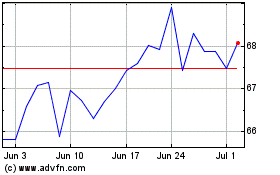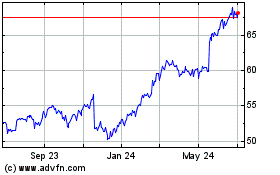U.S. Consumer Sentiment Slips
November 25 2015 - 11:10AM
Dow Jones News
U.S. consumer confidence slipped at the end of November,
suggesting retailers could face a challenging holiday season.
The University of Michigan final consumer sentiment index for
November fell to 91.3 from a midmonth reading of 93.1. The final
October reading stood at 90.0. Economists surveyed by The Wall
Street Journal had predicted the final November index would edge
down slightly to 93.0.
Consumer sentiment is still near the past six months' average of
91.6, but Americans' spending habits haven't matched their rosy
outlook. After more than a year of low gas prices and steady job
creation, many areas of the retail market remain lackluster.
Wages have been slow to rise, and prices of necessities like
medical care and shelter are climbing, eating up larger shares of
workers' paychecks. Consumer sentiment is also sensitive to market
gyrations: a tumbling stock market pushed the index to a 2015 low
of 87.2 in September after reaching 96.1 in June.
"The data indicate that consumers have become increasingly aware
of economic cross currents in the domestic as well as the global
economy," said Richard Curtin, the survey's chief economist.
Still, the reading of 91.3 was 2.8% higher than November a year
ago.
Another gauge of consumer sentiment compiled by The Conference
Board plunged to its lowest level in more than a year, the private
research group said Tuesday.
Consumer spending accounts for roughly two-thirds of overall
economic output in the U.S. Retailers hoping that continued low
gasoline prices and a robust job market will unleash spending have
so far been disappointed.
A report from the Commerce Department released Wednesday showed
that U.S. consumers ratcheted up savings rather than spending in
October. The personal saving rate climbed to 5.6% in October, the
highest level since December 2012.
Another report released Tuesday by the Commerce Department
showed that overall consumer spending increased at a 3% rate in the
third quarter, down from the second quarter's 3.6% pace. The recent
gain was led by strong spending on long-lasting goods, like
automobiles.
U.S. retail sales barely edged up in October after stalling for
two months, the Commerce Department reported earlier this month.
Consumer spending at retailers climbed just 1.7% since October
2014, compared with a 4.7% annual increase the year before, even
though Americans have enjoyed cheap gasoline for more than a
year.
Wal-Mart Stores Inc.'s sales edged up slightly in the third
quarter, but over half of its sales are groceries. Home Depot Inc.
also had a strong third quarter, but retailers like Macy's Inc.,
Nordstrom Inc., and Dick's Sporting Goods reported weak
third-quarter results.
The National Retail Federation predicts holiday sales will rise
3.7%, only slightly less than last year's 4.1% gain.
Write to Anna Louie Sussman at anna.sussman@wsj.com
Subscribe to WSJ: http://online.wsj.com?mod=djnwires
(END) Dow Jones Newswires
November 25, 2015 10:55 ET (15:55 GMT)
Copyright (c) 2015 Dow Jones & Company, Inc.
Walmart (NYSE:WMT)
Historical Stock Chart
From Mar 2024 to Apr 2024

Walmart (NYSE:WMT)
Historical Stock Chart
From Apr 2023 to Apr 2024
